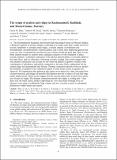| dc.contributor.author | Blair, David M. | |
| dc.contributor.author | Freed, Andrew M. | |
| dc.contributor.author | Byrne, Paul K. | |
| dc.contributor.author | Klimczak, Christian | |
| dc.contributor.author | Prockter, Louise M. | |
| dc.contributor.author | Ernst, Carolyn M. | |
| dc.contributor.author | Solomon, Sean C. | |
| dc.contributor.author | Melosh, H. Jay | |
| dc.contributor.author | Zuber, Maria | |
| dc.date.accessioned | 2014-03-21T19:37:29Z | |
| dc.date.available | 2014-03-21T19:37:29Z | |
| dc.date.issued | 2013-01 | |
| dc.date.submitted | 2012-10 | |
| dc.identifier.issn | 2169-9100 | |
| dc.identifier.uri | http://hdl.handle.net/1721.1/85889 | |
| dc.description.abstract | The Rachmaninoff, Raditladi, and Mozart peak-ring impact basins on Mercury display a distinctive pattern of tectonic features consisting of a central zone that is either devoid of tectonic landforms or contains small ridges, a medial annulus of prominent and predominantly circumferentially oriented graben, and a distal zone displaying graben that occur in a mix of orientations and that are less evident toward the peak ring. Here we use finite element models to explore three candidate scenarios for the formation of these tectonic features: (1) thermal contraction of the interior smooth plains, (2) isostatic uplift of the basin floor, and (3) subsidence following volcanic loading. Our results suggest that only thermal contraction can account for the observed pattern of graben, whereas some combination of subsidence and global contraction is the most likely explanation for the central ridges in Rachmaninoff and Mozart. Thermal contraction models, however, predict the formation of graben in the centermost region of each basin, where no graben are observed. We hypothesize that graben in this region were buried by a thin, late-stage flow of plains material, and images of partially filled graben provide evidence of such late-stage plains emplacement. These results suggest that the smooth plains units in these three basins are volcanic in origin. The thermal contraction models also imply a cooling unit ~1 km thick near the basin center, further supporting the view that plains-forming lavas on Mercury were often of sufficiently high volume and low viscosity to pool to substantial thicknesses within basins and craters. | en_US |
| dc.language.iso | en_US | |
| dc.relation.isversionof | http://dx.doi.org/10.1029/2012je004198 | en_US |
| dc.rights | Article is made available in accordance with the publisher's policy and may be subject to US copyright law. Please refer to the publisher's site for terms of use. | en_US |
| dc.source | MIT web domain | en_US |
| dc.title | The origin of graben and ridges in Rachmaninoff, Raditladi, and Mozart basins, Mercury | en_US |
| dc.type | Article | en_US |
| dc.identifier.citation | Blair, David M., Andrew M. Freed, Paul K. Byrne, Christian Klimczak, Louise M. Prockter, Carolyn M. Ernst, Sean C. Solomon, H. Jay Melosh, and Maria T. Zuber. “The Origin of Graben and Ridges in Rachmaninoff, Raditladi, and Mozart Basins, Mercury.” Journal of Geophysical Research: Planets 118, no. 1 (January 2013): 47–58. © 2012 American Geophysical Union | en_US |
| dc.contributor.department | Massachusetts Institute of Technology. Department of Earth, Atmospheric, and Planetary Sciences | en_US |
| dc.contributor.mitauthor | Zuber, Maria | en_US |
| dc.relation.journal | Journal of Geophysical Research: Planets | en_US |
| dc.eprint.version | Final published version | en_US |
| dc.type.uri | http://purl.org/eprint/type/JournalArticle | en_US |
| eprint.status | http://purl.org/eprint/status/PeerReviewed | en_US |
| dspace.orderedauthors | Blair, David M.; Freed, Andrew M.; Byrne, Paul K.; Klimczak, Christian; Prockter, Louise M.; Ernst, Carolyn M.; Solomon, Sean C.; Melosh, H. Jay; Zuber, Maria T. | en_US |
| dc.identifier.orcid | https://orcid.org/0000-0003-2652-8017 | |
| mit.license | PUBLISHER_POLICY | en_US |
| mit.metadata.status | Complete | |
